Bass fishing is a beloved pastime enjoyed by anglers worldwide. The thrill of the catch, the patience required, and the skill needed to land a big bass make this sport both exhilarating and rewarding. But the journey doesn’t end with the catch it continues when you transform your prize into a delicious meal.
In this comprehensive guide, we will walk you through the step-by-step process of filleting a bass fish, from essential equipment to expert techniques for achieving a perfect fillet. Discover the secrets of preserving the delicate flavor, and explore various cooking methods to savor the fruits of your angling adventure. Whether you’re a novice or an experienced angler, our tips will help you master the art of filleting a bass fish and turn your catch into a culinary masterpiece.
Understanding the World of Bass Fishing
Understanding the world of bass fishing is essential for anglers. Three primary bass types, including largemouth, smallmouth, and spotted bass, inhabit various environments. Equipment selection is critical, with medium-heavy to heavy-action rods, suitable reels, and effective baits. Anglers must also consider catch and release practices and adherence to local fishing regulations. Before diving into the intricacies of filleting a bass fish, let’s explore the basics of bass fishing.
Types of Bass
Bass fishing enthusiasts commonly target two primary species, the largemouth bass and the smallmouth bass. Largemouth bass are known for their size and ferocious strikes, while smallmouth bass are celebrated for their fighting spirit and acrobatic leaps. These distinct species provide unique challenges and rewards for anglers.
| Bass Variety | Description | Habitat |
| Largemouth Bass | Distinguished by large mouths and aggressiveness in feeding. | Lakes, rivers, ponds, freshwater |
| Smallmouth Bass | Smaller and known for their fighting spirit. | Colder waters |
| Spotted Bass | Common in the southern United States with dark spots along their lateral line. | Warm, southern waters |
Bass Fishing Equipment
When it comes to bass fishing equipment, having the right gear is essential. Start with a quality fishing rod and reel combination, designed for bass. Choose the right line strength, typically 8-12 lb test, and stock up on various bass lures, such as jigs, crankbaits, and soft plastics. Don’t forget essential accessories like a sharp fillet knife for preparing your catch and a reliable tackle box to keep everything organized. Proper equipment can make all the difference in your bass fishing success.

| Equipment | Description |
| Fishing Rod and Reel | Choose a medium-heavy to heavy-action rod with a baitcasting or spinning reel. |
| Fishing Line | Select a 10-20 lb test line depending on the target bass size. |
| Lures and Baits | Popular choices include plastic worms, crankbaits, jigs, and live bait. |
Catch and Release vs. Keeping Bass
When it comes to bass fishing, anglers often face the dilemma of whether to catch and release or keep their catch. Catch and release is a conservation-minded approach, allowing bass to thrive and maintain healthy populations. On the other hand, keeping bass for consumption is a popular practice, providing a delicious meal. Balancing both methods requires understanding local regulations and environmental considerations to sustain bass populations while enjoying the benefits of a fresh catch.
| Approach | Description |
| Catch and Release | A sustainable practice to conserve bass populations, especially for trophy-sized fish. |
| Keeping Bass | Ensure you adhere to local fishing regulations and size limits. |
Preparing for the Bass Fillet
Before you embark on filleting a bass, it is essential to prepare your workspace and gather the necessary tools. Find a clean, well-lit area and lay out a sharp fillet knife, cutting board, and a bowl for the fillets. Make sure your bass is properly cleaned and scaled. It’s also crucial to have a firm grip and a steady hand to ensure safe and precise cuts. Proper preparation ensures a smoother and more efficient filleting process.
Gather Your Tools
Before you embark on the journey of filleting a bass fish, make sure you have the right tools at your disposal. Essential items include a sharp fillet knife, a cutting board, gloves for safety, a container for waste disposal, and a clean workspace. Having the right equipment ensures a smooth and efficient filleting process, allowing you to enjoy your catch with minimal effort and maximum satisfaction.
Essential Tools for Bass Filleting
| Tool | Purpose |
| Sharp Fillet Knife | For precise and clean cuts. |
| Cutting Board | Provides a stable cutting surface. |
| Latex Gloves | Maintain a secure grip and keep hands clean. |
| Scaler or Descaler | Needed for scale removal (if applicable). |
| Trash Container | For easy disposal of waste. |
opt for an outdoor table or a designated fish-cleaning station. It should be well-ventilated and easy to clean. Organize your tools on the workspace for quick access.
The Bass Filleting Process Step By Step
Subdue the fish properly. If practicing catch and release, ensure you minimize harm and stress to the fish.When keeping the bass, use a stringer or a cooler with ice to maintain freshness.
Scaling the Fish Some anglers prefer to remove the scales from the bass before filleting. Use a scaler or fish descaler tool for this purpose.
Gutting the Fish Place the bass dorsal fin up on the cutting board.Make a shallow incision behind the gills and the pectoral fin. Extend the cut towards the anus, avoiding damage to the internal organs. Remove the entrails gently, ensuring there’s no blood or debris left behind.Rinse the fish thoroughly to eliminate any remaining traces of blood and innards.
Making the First Cut With the bass belly-up, create a vertical cut just behind the pectoral fin, from the top of the fish down to the spine.This cut determines the fillet’s width, so make it as wide as desired.
Fillet the First Side Turn the fish on its side, with the dorsal fin facing you.Insert your fillet knife into the initial incision.Carefully follow the ribcage and spine’s contours, keeping the blade in contact with the bones for maximum flesh yield.Angle the knife slightly downwards, ensuring the blade remains in contact with the bones.Continue until you reach the tail, then separate the fillet from the fish.
Repeat on the Other Side Flip the bass over to its other side and repeat the filleting process to remove the second fillet. Strive to create symmetrical cuts for uniform fillets.
Removing the Skin (Optional)While bass skin is edible and flavorful, some prefer to remove it for a milder taste.To do this, place the fillet skin-side down on your cutting board .Use your fillet knife to gently separate the flesh from the skin, minimizing waste.
Inspect and Clean the Fillets Check the fillets for any remaining bones or scales. Remove them using your knife or fish tweezers. Rinse the fillets under cold water to eliminate any stray scales, blood, or debris.
Cooking and Savoring Your Bass Fillets
With your freshly filleted bass, it’s time to decide how to prepare and enjoy your catch. Here are some cooking suggestions.

Pan-Frying Season the fillets with salt, pepper, and preferred spices.Dredge them in a mixture of flour or cornmeal.Heat a pan with oil or butter over medium-high heat.Cook the fillets for 3-4 minutes on each side until golden brown and flaky.
Grilling Marinate the fillets in your choice of marinade for at least 30 minutes.Preheat the grill to medium-high heat.Oil the grill grates to prevent sticking.Grill the fillets for 4-6 minutes per side until they are cooked through and display grill marks.
Baking Preheat your oven to 350°F (175°C).Place the fillets in a baking dish, season, and add seasonings or sauce. Bake for 15-20 minutes or until the fish flakes easily with a fork.
Ceviche Cube the fillets and marinate in a mixture of lime or lemon juice, onions, cilantro, and peppers.Allow it to sit in the refrigerator for at least 30 minutes.Serve with tortilla chips for a refreshing and zesty appetizer.
FAQs
What are the primary types of bass ?
The main types of bass discussed in the article are largemouth bass, smallmouth bass, and spotted bass, each with distinct characteristics and habitats.
How should I prepare a bass fish for filleting?
To prepare a bass fish for filleting, begin by making an incision behind the gills and pectoral fin, extending it to the anus, followed by removing the entrails and rinsing the fish thoroughly before proceeding with filleting.
Is it necessary to remove scales from a bass before filleting?
No, it’s not necessary to remove scales from a bass before filleting. It is an optional step, and some anglers use scaler or descaler tools for this purpose.
What are the recommended cooking methods for bass fillets?
Recommended cooking methods for bass fillets include pan-frying, grilling, baking, and making ceviche, offering various ways to enjoy your fresh catch.
How can I make catch and release bass fishing more sustainable?
To make catch and release bass fishing more sustainable, adhere to local fishing regulations and size limits, handle fish gently, use barbless hooks, and release the fish with minimal harm or stress, ensuring the population’s conservation.
Conclusion
Mastering the art of filleting a bass fish is a valuable skill that enhances your bass fishing experience. It ensures that your prized catch is transformed into a delightful meal. Whether you prefer to pan-fry, grill, bake, or experiment with other cooking methods, the fresh taste of bass will leave you yearning for more. The journey from the catch to the plate is a rewarding one, and it’s an integral part of the bass fishing tradition. So, next time you reel in a beautiful bass, remember to enjoy the entire process and savor the fruits of your labor. Happy fishing and bon Appetit.

